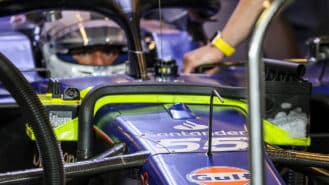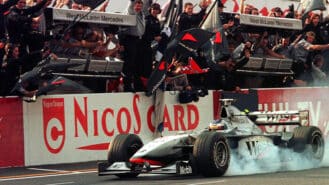So if, as seems to be the case, Red Bull will be building its own engines in 2016 – with a Mario Illien-developed version of the Renault, probably using Red Bull’s own energy recovery systems – it re-unites the Adrian Newey/Mario Illien partnership of McLaren-Mercedes of the late ‘90s/early 2000s.

In many ways, they are two of a kind. Extreme and uncompromising in their technical vision, their designs are invariably on the edge, occasionally over it. Once, they even compounded each other’s aggressive striving when Newey asked Illien if it was possible to lower the Merc’s crank height by a significant margin.
From the archive: Mario Illien’s part in the last great unfair advantage (2010)
Mario felt that it was – but that engine consistently blew itself to pieces and lost the team its chance of the 2003 world title. That was also the season in which Newey’s MP4-18 never raced, such was its complexity and frailty. But when they got it right it was spectacular. Their high-point has to be the 1998 McLaren MP4-13 that dominated the season to give Mika Häkkinen his first world title (below).


Illien was brought in by Red Bull – and at Red Bull’s expense – late last year as an engine consultant in an effort at helping Renault Sport get to the bottom of its power unit problems. But it was always an awkward mesh. For years Illien and his Mercedes motors had been ‘the enemy’ at Renault and there was a perhaps understandable reluctance from the French side for all information to be free-flowing. At the engineer level, there was mutual respect. But at a managerial level there was a very tightly cordoned-off area – and what in essence happened was that two separate development paths were created for 2015, an Illien one and a ‘French’ one.
Illien’s original single-cylinder prototype early in the season gave no better results than what Renault was already developing. But a later single-cylinder study, with further improved combustion, proved much more promising – at around four per cent better than the current Renault motor. But development of it was not followed up as Renault Sport awaited the outcome of its parallel study.

This will form the basis of the 2016 Renault Sport engine while the Illien development will be foundation of the Red Bull engine. Both are Renault-based but with different combustion philosophies and different electrical ers systems. Red Bull had already been manufacturing key parts of this system to supply to Renault.
The relationship between Red Bull and Renault had reached such a low that their divorce was inevitable. Now Red Bull is on the one hand a paying customer and on the other a power unit development company, at least putting itself in more control of its destiny – the lack of which was only underlined by the understandable reluctance of Mercedes and Ferrari to supply them.

Part – but only part – of the problem was that in many ways it remains F1’s top team with arguably still the best aerodynamics, the fastest pit stops, the quickest new development parts turnaround. But it won its four titles during a time of frozen engine equality. As soon as that was rescinded by the hybrid formula of 2014, so that weakness came to count. Regardless of how you view their threats of walk-out – and in this it’s helpful to remember that it is merely a marketing arm of a business, rather than only a race team and as such owes the sport nothing – it adds much to F1 and in reality it would have been a great shame to see it go.
From the archive: Mario Illien’s part in the last great unfair advantage (2010)
Once this news is confirmed it remains to be seen how the token system applies but presumably it follows the Renault token usage to date, then takes it from there once the season begins.
A colleague of mine posed a very amusing question about the expected Red Bull engine though. “If it’s any good,” he asked. “Will they supply it to other teams?”








